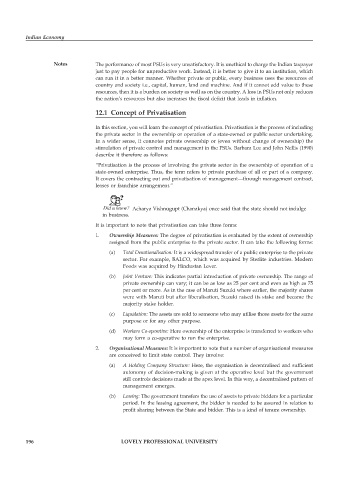Page 201 - DECO303_INDIAN_ECONOMY_ENGLISH
P. 201
Indian Economy
Notes The performance of most PSUs is very unsatisfactory. It is unethical to charge the Indian taxpayer
just to pay people for unproductive work. Instead, it is better to give it to an institution, which
can run it in a better manner. Whether private or public, every business uses the resources of
country and society i.e., capital, human, land and machine. And if it cannot add value to these
resources, then it is a burden on society as well as on the country. A loss in PSUs not only reduces
the nation’s resources but also increases the fiscal deficit that leads in inflation.
12.1 Concept of Privatisation
In this section, you will learn the concept of privatisation. Privatisation is the process of including
the private sector in the ownership or operation of a state-owned or public sector undertaking.
In a wider sense, it connotes private ownership or (even without change of ownership) the
stimulation of private control and management in the PSUs. Barbara Lee and John Nellis (1990)
describe it therefore as follows:
“Privatisation is the process of involving the private sector in the ownership of operation of a
state-owned enterprise. Thus, the term refers to private purchase of all or part of a company.
It covers the contracting out and privatisation of management—through management contract,
leases or franchise arrangement.”
Did u know? Acharya Vishnugupt (Chanakya) once said that the state should not indulge
in business.
It is important to note that privatisation can take three forms:
1. Ownership Measures: The degree of privatisation is evaluated by the extent of ownership
assigned from the public enterprise to the private sector. It can take the following forms:
(a) Total Denationalisation: It is a widespread transfer of a public enterprise to the private
sector. For example, BALCO, which was acquired by Sterlite industries. Modern
Foods was acquired by Hindustan Lever.
(b) Joint Venture: This indicates partial introduction of private ownership. The range of
private ownership can vary; it can be as low as 25 per cent and even as high as 75
per cent or more. As in the case of Maruti Suzuki where earlier, the majority shares
were with Maruti but after liberalisation, Suzuki raised its stake and became the
majority stake holder.
(c) Liquidation: The assets are sold to someone who may utilise those assets for the same
purpose or for any other purpose.
(d) Workers Co-operative: Here ownership of the enterprise is transferred to workers who
may form a co-operative to run the enterprise.
2. Organisational Measures: It is important to note that a number of organisational measures
are conceived to limit state control. They involve:
(a) A Holding Company Structure: Here, the organisation is decentralised and sufficient
autonomy of decision-making is given at the operative level but the government
still controls decisions made at the apex level. In this way, a decentralised pattern of
management emerges.
(b) Leasing: The government transfers the use of assets to private bidders for a particular
period. In the leasing agreement, the bidder is needed to be assured in relation to
profit sharing between the State and bidder. This is a kind of tenure ownership.
196 LOVELY PROFESSIONAL UNIVERSITY

